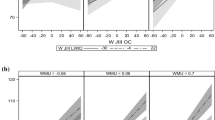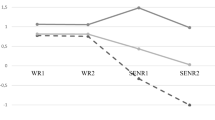Abstract
The present study is predicated on the logic of interrelated functional information processing components as an approach to understanding reading and its difficulties in preadolescent readers. The structural equation modelling (and its variants) involved these three latent components: (a) orthographic/phonological component, (b) morphological component, and (c) sentence and paragraph comprehension component. These components were subserved by a total of ten measurable tasks, all administered on-line via the microcomputer under laboratory conditions with reaction time measures as indices of mental representation of word knowledge and sentence/paragraph comprehension. The latent dependent component of reading performance was subserved by standardized vocabulary and reading comprehension tests. The total sample consisted of 298 children in grades, 4, 5, and 6. Maximum likelihood analyses using LISREL show that the data in general do not disconfirm the proposed model for grade 4 readers. The three-component model, with some variables set free, provides a reasonable fit for the grade 5 data but less claim could be made about the goodness of fit for grade 6. The results show the mutually reinforcing and mutually facilitating effects of multilevels and multicomponents of reading. Word structure and word knowledge are particularly predictive of reading. The present Phase 1 work would be validated in a follow-up of another cohort of readers and would also lead to the systematic training of some of the components with poor readers.
Similar content being viewed by others
References
Aaronson, D. 1984. Computer methods and ecological validity in reading research.Behavior Research Methods, Instruments, and Computers 16: 102–108.
Aronoff, M. 1976.Word Formation in Generative Grammar. Cambridge, MA: MIT Press.
Baron, J. and Strawson, C. 1976. Use of orthographic and word-specific knowledge in reading words aloud.Journal of Experimental Psychology: Human Perception and Performance 2:386–393.
Beck, I. L. and Carpenter, P. A. 1986. Cognitive approaches to understanding reading: Implications for instructional practice.American Psychologist 41:1098–1105.
Bentler, P. M. 1980. Multivariate analysis with latent variables: Causal modeling.Annual Review of Psychology 31:419–456.
Bentler, P. M. 1986. Structural modeling and Psychometrika: An historical perspective on growth and achievements.Psychometrika 51:35–51.
Berko, J. 1958. The child’s learning of English morphology.Word 14:150–177.
Calfee, R. 1982. Cognitive models of reading: Implications for assessment and treatment of reading disability.In R. N. Malatesha and P. G. Aaron (eds.).Reading Disorders: Varieties and treatments (pp. 151–176). New York: Academic Press.
Carlisle, J. F. 1985. The relationship between knowledge of derivational morphology and spelling ability in fourth, sixth, and eighth graders.Haskins Laboratories Status Report on Speech Research SR-82/83, 151–174.
Carlisle, J. F. 1987. The use of morphological knowledge in spelling derived forms by learning disabled and normal students.Annals of Dyslexia 37:90–108.
Clark, H. H. and Chase, W. G. 1972. On the process of comparing sentences against pictures.Cognitive Psychology 3:472–517.
Cliff, N. 1983. Some cautions concerning the application of causal modeling methods.Multivariate Behavioral Research 18:115–126.
Coltheart, M. 1980. Reading, phonological recoding, and deep dyslexia.In M. Coltheart, K. Patterson, and J. C. Marshall (eds.).Deep Dyslexia (pp. 197–226). London: Routledge and Kegan Paul.
Connell, J. P. and Tanaka, J. S. (eds.). 1987. Structural equation modeling [Special section].Child Development 58(1):1–175.
Crowder, R. G. 1984. Is it just reading? Comments on the papers by Mann, Morrison, and Wolford and Fowler.Developmental Review 4:48–61.
Downing J. and Leong, C. K. 1982.Psychology of Reading. New York: Macmillan.
Elliott, C. D., Murray, D. J., and Pearson, L. S. 1978.British Ability Scales: Manual 3: Directions for administration and scoring and Manual 4: Tables of abilities and norms. Windsor, Berks: NFER.
Fischer, F. W., Shankweiler, D., and Liberman, I. Y. 1985. Spelling proficiency and sensitivity to word structure.Journal of Memory and Language 24: 423–441.
Forster, K. I. 1976. Accessing the mental lexicon.In R. J. Wales and E. Walker (eds.).New Approaches to Mental Mechanisms (pp. 257–287). Amsterdam: North-Holland.
Fowler, C. A., Napps, S. E., and Feldman, L. B. 1985. Relations among regular and irregular, morphologically-related words in the lexicon as revealed by repetition priming.Memory & Cognition 13: 241–255.
Frederiksen, J. R. 1981. Sources of process interactions in reading.In A. M. Lesgold and C. A. Perfetti (eds.).Interactive Processes in Reading (pp. 361–386). Hillsdale, NJ: Erlbaum.
Frederiksen, J. R. 1982. A componential theory of reading skills and their interactions.In R. J. Sternberg (ed.),Advances in the Psychology of Human Intelligence (Vol. 1) (pp. 125–180). Hillsdale, NJ: Erlbaum.
Frederiksen, J. R. and Warren, B. M. 1987. A cognitive framework for developing expertise in reading.In R. Glaser (ed.).Advances in Instructional Psychology (Vol. 3) (pp. 1–39). Hillsdale, NJ: Erlbaum.
Frederiksen, J. R., Warren, B. M., and Rosebery, A. S. 1985a. A componential approach to training reading skills: Part 1. Perceptual units training.Cognition and Instruction 2:91–130.
Frederiksen, J. R., Warren, B. M., and Rosebery, A. S. 1985b. A componential approach to training reading skills: Part 2. Decoding and use of context.Cognition and Instruction 2:271–338.
Gibson, E. J. and Levin, H. 1975.The Psychology of Reading. Cambridge, MA: MIT Press.
Haines, L. and Leong, C. K. 1983. Coding processes in skilled and less skilled readers.Annals of Dyslexia 33: 67–89.
Harris, P. L., Kruithof, A., Terwogt, M. M., and Visser, T. 1981. Children’s detection and awareness of textual anomaly.Journal of Experimental Child Psychology 31: 212–230.
Henderson, L. 1982.Orthography and Word Recognition in Reading. London: Erlbaum.
Henderson, J. 1985. Toward a psychology of morphemes.In A. W. Ellis (ed.).Progress in the Psychology of Language (Vol. 1) (pp. 15–72). London: Erlbaum.
Humphreys, G. W. and Evett, L. J. 1985. Are there independent lexical and nonlexical routes in word processing? An evaluation of the dual route theory of reading.The Behavioral and Brain Sciences 8: 689–740.
Jöreskog, K. G. 1981. Analysis of covariance structure.Scandinavia Journal of Statistics 8: 65–92.
Jöreskog, K. G. and Sörbom, D. 1982. Recent developments in structural equation modeling.Journal of Marketing Research 19: 404–416.
Jöreskog, K. G. and Sörbom, D. 1984.LISREL VI: Analysis of linear structural relationships by the method of maximum likelihood. Chicago: Scientific Software, Inc.
Kieras, D. and Just, M. (eds.). 1985.New Methods in Reading Comprehension Research. Hillsdale, NJ: Erlbaum.
King, E. M. (ed.). 1982.Canadian Tests of Basic Skills: Multilevel edition/Levels 9–12/Forms 5 & 6. Toronto: Nelson.
Klima, E. S. 1972. How alphabets might reflect language. In J. F. Kavanagh and I. G. Mattingly (eds.).Language by Ear and by Eye (pp. 57–80). Cambridge, MA: MIT Press.
Leong, C. K. 1984. Cognitive processing, language awareness, and reading in grade 2 and grade 4 children.Contemporary Educational Psychology 9: 369–383.
Leong, C. K. 1987.Children with Specific Reading Disabilities. Lisse, The Netherlands: Swets and Zeitlinger.
Leong C. K. 1988.Morphological structure and its effect on reading proficiency. Manuscript in preparation.
Luszcz, M. A., Bungey, J., and Geffen, G. 1984. Orthographic-morphemic factors in reading: A developmental study.Australian Journal of Psychology 36: 355–365.
Markman, E. M. 1979. Realizing that you don’t understand: Elementary school children’s awareness of inconsistencies.Child Development 50: 643–655.
Markman, E. M. 1985. Comprehension monitoring: Developmental and educational issues.In S. F. Chipman, J. W. Segal, and R. Glaser (eds.).Thinking and Learning Skills, Vol. 2: Research and open questions (pp. 275–291). Hillsdale, NJ: Erlbaum.
McKeown, M. G. and Curtis, M. E. (eds.). 1987.The Nature of Vocabulary Acquisition. Hillsdale, NJ: Erlbaum.
Miller, G. A. and Gildea, P. M. 1987. How children learn words.Scientific America 257: 94–99.
Morrison, F. J. 1984. Reading disability: A problem in rule learning and word decoding.Developmental Review 4: 36–47.
Olson, R. K. 1985. Disabled reading processes and cognitive profiles.In D. B. Gray and J. F. Kavanagh (eds.),Biobehavioral Measures of Dyslexia (pp. 215–243). Baltimore, MD: York Press.
Olson, R. K. and Keenan, J. M. 1985. Segmentation in models of reading.The Behavioral and Brain Sciences 8:719–720.
Olson, R. K., Kliegl, R., Davidson, B. J., and Folts, G. 1985. Individual and developmental differences in reading disability.In G. E. Mackinnon and T. G. Waller (eds.).Reading Research: Advances in theory and practice (Vol. 4) (pp. 1–64). New York: Academic Press.
Palincsar, A. S. and Brown, A. L. 1984. Reciprocal teaching of comprehension-fostering and comprehension-monitoring activities.Cognition and Instruction 1: 117–175.
Palmer, J., MacLeod, C. M., Hunt, E., and Davidson, J. E. 1985. Information processing correlates of reading.Journal of Memory and Language 24: 59–88.
Perera, K. 1984.Children’s Writing and Reading. London: Basil Blackwell.
Perfetti, C. A. 1985.Reading Ability. New York: Oxford University Press.
Perfetti, C. A. 1986. Cognitive and linguistic components of reading ability.In B. R. Foorman and A. W. Siegel (eds.).Acquisition of Reading Skills: Cultural constraints and cognitive universals (pp. 11–40). Hillsdale, NJ: Erlbaum.
Polich, J., McCarthy, G., Wang, W. S., and Donchin, E. 1983. When words collide: Orthographic and phonological interference during word processing.Biological Psychology 16: 155–180.
Saffran, E. M. and Marin, O. S. M. 1977. Reading without phonology: Evidence from aphasia.Quarterly Journal of Experimental Psychology 29: 515–525.
Seidenberg, M. S. 1985a. The time course of phonological code activation in two writing systems.Cognition 19: 1–30.
Seidenberg, M. S. 1985b. The time course of information activation and utilization in visual word recognition.In D. Besner, T. G. Waller, and G. E. Mackinnon (eds.).Reading Research: Advances in theory and practice, Vol. 5. (pp. 199–252). New York: Academic Press.
Taft, M. 1985. The decoding of words in lexical access: A review of the morphological approach.In D. Besner, T. G. Waller, and G. E. Mackinnon (eds.).Reading Research: Advances in theory and practice (Vol. 5) (pp. 83–123). New York: Academic Press.
Wong, B.Y.L. 1985. Self-questioning instructional research: A review.Review of Educational Research 55: 227–268.
Wright, B. and Garrett, M. 1984. Lexical decision in sentences: Effects of syntactic structure.Memory and Cognition 12: 31–45.
Author information
Authors and Affiliations
Additional information
This study was supported by a grant (No. 410-86-0048) from the Social Sciences and Humanities Research Council of Canada.
Rights and permissions
About this article
Cite this article
Leong, C.K. A componential approach to understanding reading and its difficulties in preadolescent readers. Annals of Dyslexia 38, 95–119 (1988). https://doi.org/10.1007/BF02648250
Issue Date:
DOI: https://doi.org/10.1007/BF02648250




